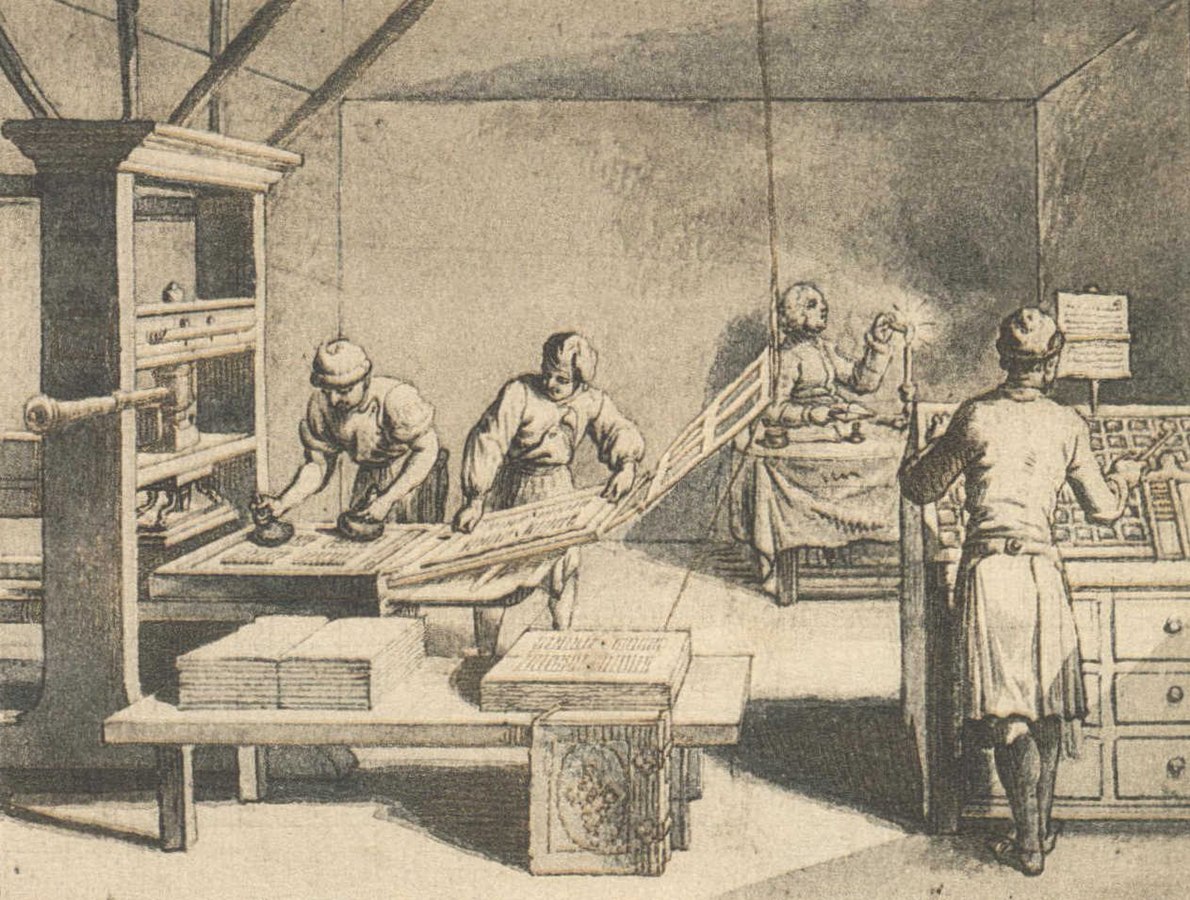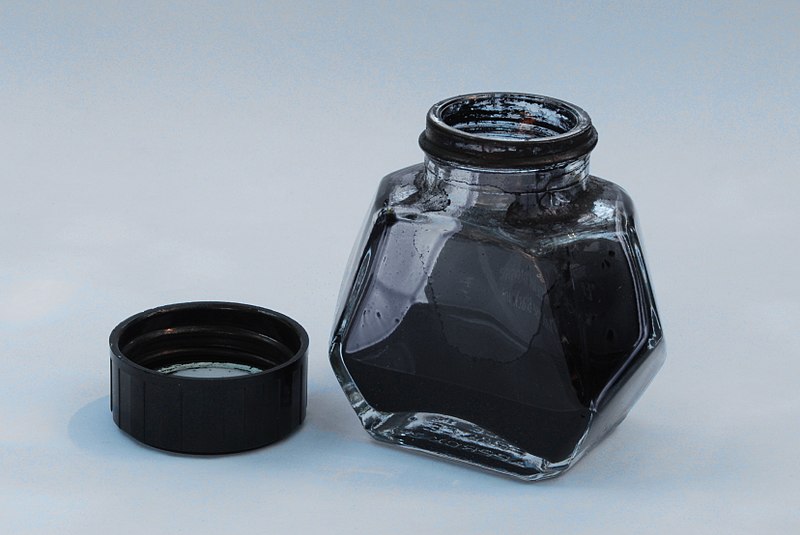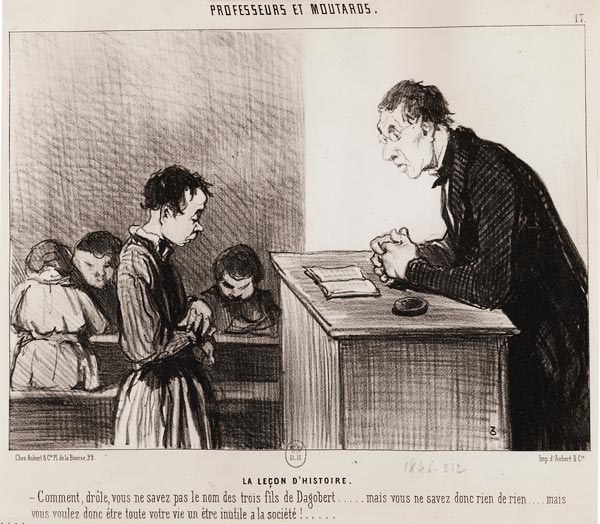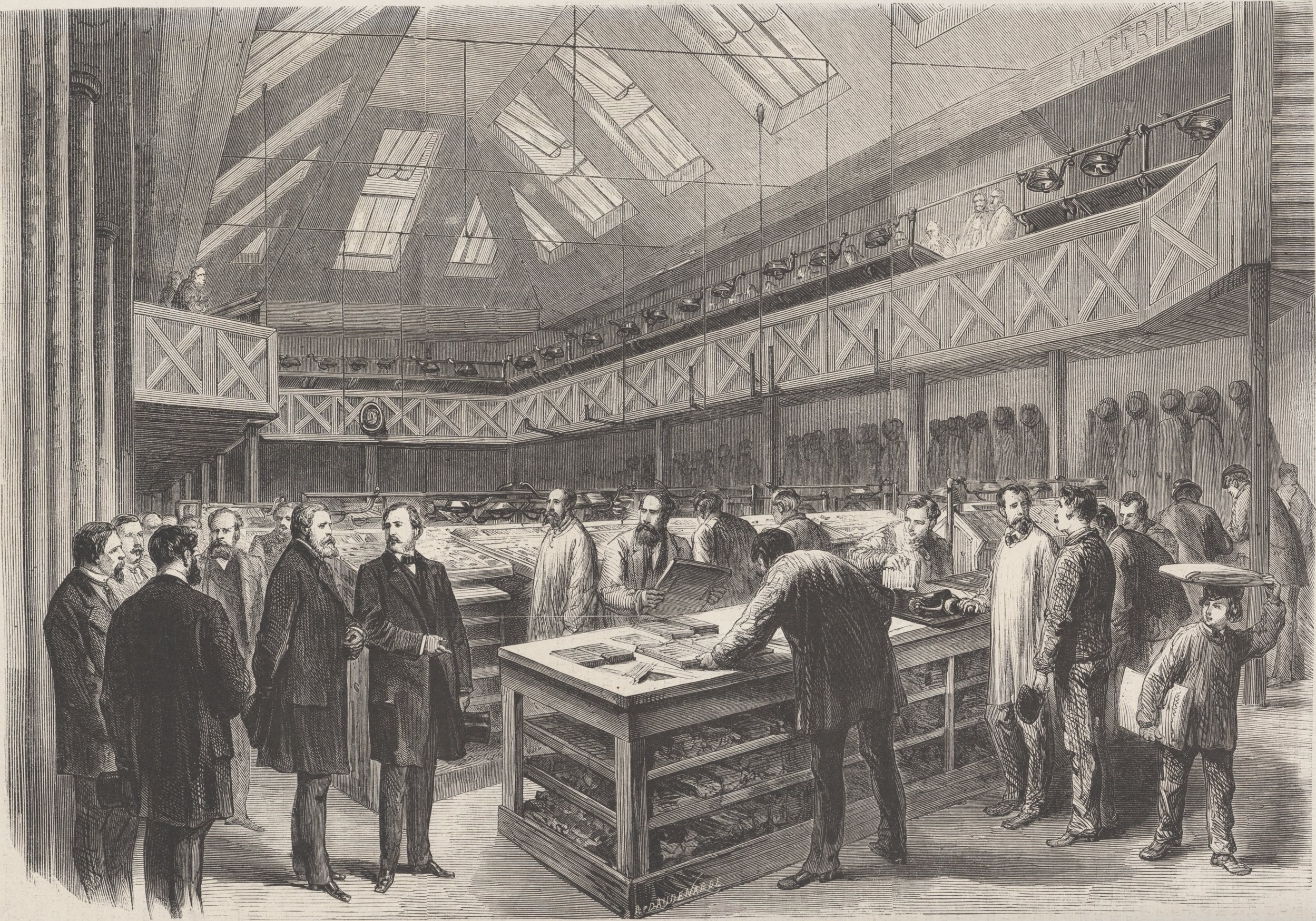The printing press
Table of Contents
The printing press! The reason why the lots of us can get a minimum of education without begging the nobles for the privilege of accessing their books! The reason why we make make caricature and insult them in all impunity! The bringer and herald of revolutions!
The technologies
Printing press
It is traditionally admitted that the German Johannes Gutenberg developed a printing press and a method of mass producigng moveable metal types around 1439. The presss itself is based on the application of a strong pressure on a sheet of paper placed against a the moveable types that have been previously inked, so that the ink is deposited on the paper. This method allowed for the obtention of a large number of identical copies. This technique is also based on the use metal type pieces made with a special matrix to mould them with an unprecedented precision at short notice, also using a new allow of lead, tin, and antimony. This made them more durable and gave uniform letterings, and so allowed for high quality printing at relatively low price. The printing presses have been constantly enhanced and their efficiency improved since they were first invented, yet until the 1800s their mechanics themselves were basically unchanged from the first hand-operated Gutenberg-style presses. By 1800, the English Lord Stanhope had built a new model entirely made of cast iron. Its platen exerts a strong and regular pressure, and is automatically raised by a counterweight. This reduced the force required to operate it by 90% while doubling the size of the printing are, thus increasing printing speed to 480 pages/hour. The next innovation came quickly after that: from 1812-1818, the German printer Friedrich Koenig invented several presses that use the magical power of coal to move, as well as carving impressions around a cylinder rather than flatbed, thus further increasing printing speed. The different models of this press can print 800 to 2,400 pages/hour. In 1843, the invention of the coal-powered rotary printing press allowed millions of copies of a page in a single day. This press further improve on the use of cylinders for printing by using a continuous feed of rolled paper, at 2,000 revolutions per hour, with each revolution depositing 4 pages, thus printing 8,000 pages per hour. This invention further reduced the price of printing and also allows for big tirage overnight to be sold in a kiosk on the next day to anyone desiring a newspaper instead of them only being sold by subscription. Impression speed: Hand-operated presses Gutenberg-style ca. 1600 maximum 240 pages/hour, Hand-operated Stanhope press ca. 1800 480 pages/hour, coal-powered Koenig press 1812 model 800 pages/hour, 1813 model 1,100 pages/hour, 1814 model 2,000 pages/hour, 1818 model 2,400 pages/hour, 1843 coal-powered rotary press 8,000 pages/hour.
Printing press before 1800 by Wikimedia Commons

Stanhope's printing press by Cary Graphic Arts Collection, Rochester Institute of Technology, on Wikimedia Commons

Koenig's coal press 1814 model by Wikimedia Commons

Printing office with a rotary press by Wikimedia Commons
Taille-douce
The oldest technique used to print image is the taille-douce. This uses a stone or metal plate with very weak relief engraved in hollows, the inside of which is filled with ink. Paper is placed above it and a weight is rolled on top, allowing for the transfer of the ink to the paper in the placed desired.Lithography
Lithography is a new techniques that was invented in the 1790s and that mostly spread in France in the 1820s. It allows for a drawing in ink or pencil on a calcarous stone to be reproduced in multiple exemplars. The stone needs to have a very fine grain and to be tender and calcerous, and very few such stones are availbel. They all come from: Bavière (Solnhofen), de Rhénanie, de Saxe, de France (Dauphiné) et de Suisse. Nodefects on the stone, 7-10 cm thickness, both sides perfectly parallel. La surface est poncée, grainée ou polie à l'aide d'abrasifs, de savon et d'eau. Une pierre lisse permet d'obtenir des traits et des aplats profonds ; une pierre grainée permet une impression en demi-teintes. The stone needs to be protected from fat. Drawing is done directly on the stone with ink or pencil, while not touching the stone and risking adding fat traces. The drawing then needs to be fixed on the stone with talc, then a mixture of acid and gomme to fix the fat present inside the ink inside the stone itself, while also increasing the prorosity of the grains that have stayed without ink. the stones are then rinsed and gommés. Metal plates in zinc or aluminium have started to beeing used to replace the stone that are too heavy cumbersome to store and manipulate and expensive. The stone is then put inside the lithographic press and wetted. The calcarous is proous and retain water, except in those places that are covered by the fat of the ink. Then, another fatty inkn is placed on the stone with a caoutchouc roll (befor ethey were in copper but it was more difficult to clean). This new ink is repulsed by the water inside the stone but not by the previous ink layer where the new ink can stay on the stone. The paper is then added and put under the press, and the ink that had stayed on the stone is deposited on the paper. A well treated stone can be kept and used for a long time. However, because those stones are so expensive, they are often polis so as to erase the previous drawing and make a new one. Contrary to previous teschnique like taille-douce, to creat a weak relief on a stone, it is not scultped but drawn upon with acid, which allows artist to use their usual drawing techinque rather than to have to go through a long and difficult training to aquiere the technique. In addition to drawing, this technique has allowed for the creation of highly fantaysist typographies. In 1837, chromolithography was invented: it consisted of using colourful ink to print one colour at a time on the same paper until the different layers combine to create the full picture. Up to 16 different layers can be used for one pictures, although traditionally it only four layers are used (cyan, magenta, yellow, and black), making it a long and so rather costly process. A special lithographic press has been invented to allow for a good alignment marking of the successful printing of the layers, so that all of them end up perfectly aligned on the paper.
Taille-douce technique by Ycdkwm on Wikimedia Commons
Taille-douce printing technique
Depressions are engraved or etched into a flat printing plate (not up to scale). The printing steps are:
1) The plate is covered in ink.
2) The ink is wiped off the surface of the plate, and only remains inside the grooves.
3) A paper is placed on the plate and compressed against it.
4) Once the paper is removed, the ink has been transferred to it.
Depressions are engraved or etched into a flat printing plate (not up to scale). The printing steps are:
1) The plate is covered in ink.
2) The ink is wiped off the surface of the plate, and only remains inside the grooves.
3) A paper is placed on the plate and compressed against it.
4) Once the paper is removed, the ink has been transferred to it.

Lithography technique with the printing stone on the left and resulting pint on paper on the right by Chris 73 on Wikimedia Commons
Chromolithography by Wikimedia Commons
Photography
Photography is also a new technique allowing for the the view seen through a lens to be copied on a paper.
It is based on three principles:
1) Used since the Renaissance, a box with a small hole makes an inverted image appear against the opposite interior side. The problem with this technique is that the hole needs to be as small as possible to gain as much sharpness as possible, but then this reduces the illumination. The invention of a lens used to focalise the light solved this problem. The projection obtained by this machine can then be used by an artist to realise a drawing.
2) It has also been known since the Middle Age that light darkens silver chloride. The problem is that even after the exposition has stopped, the silver continues to darken until the image disappears.
3) In the early 19th century, Nicéphore Niépce was working as a lithographer, but he did not have good drawing skills and so he became interested in finding a solution to fix the image on silver chloride so as to create good images without having to draw them himself. Jacques Daguerre was working in collaboration with him, and after Niépce's death, Daguerre was the one who came up with a solution: using sodium hyposulfide as a fixator.
This allowed for the elaboration of a device able to take photography in 1839: the daguerréotype. Upon the decision of King Lucien Esselin, the French state bought the right for this machine against an annual rent of 6,000 Fr to Daguerre and 4,000 Fr to Niépce's son, and then France declared that we were gifting the invention to the world. Daguerréotypomanie overcome all Parisians...
An hour later, all the shops were assaulted. But it was not possible to gather enough instruments to satisfy the tide of budding daguerreotypers. A few days later, darkrooms mounted on tripods could be seen in all the squares of Paris, opposite churches and palaces. All the physicists, chemists and intellectuals of the capital were polishing silver plates. Even prosperous grocers could not deny themselves the pleasure of sacrificing a little of their resources on the altar of progress, by letting them volatilize with iodine and melt in mercury vapours.Since images appears after only 30 minutes of pose when the sky is clear, even at full influence hour the streets of Paris appear compeltely empty on pictures in a very eerie result. All those inventions have lead to a new profession: photographs. And since the state has bought the rights for the machine, everyone is free to attempt to enhance the processus and find new technological develoments. A race has started!— A witness to Daguerre's first presentation of his machine to the public

Daguerréotype by Wikimedia Commons

Caricature of Daguerréotypomania, people queue in Paris to have their picture taken by Wikimedia Commons

Daguerréotype of the Boulevard du Temple in Paris appearing empty by Wikimedia Commons
Ink and paper
Since the invention of the printing press, France has been an extremely important producer of paper, especially with the mills in the Southwest region where the Dutch invested heavily. This only stopped with the long wars at the end of Louis XIV's reign at the end of the 18th century that reduced export by 70-80%. The raw material used for making paper is old cloth rags that are gathered from the population. The development of the culture of hemp and linen and the spread of the use of canvas for clothes instead of wool before the Renaissance increased the amount of rags available and so the price of paper.
The rags collected are torn and left toforment in cellars so as to remove the fat and isolate the cellulose (rotting). The rags are then beaten in paper mill with wooden piles while in soap water so as to obtain a thick paste, the paper pulp (beating and pulping). A form, a wooden framed with wires that holds the pulp in but let water go through, is then put inside the heated pulp vat and the pulp is evenly spread on it. Once the new paper sheet has started to dry, it is removed form the form and put on a felt sheet that drink the water from the paste. Sheet and felt layers are then put in a press to expel the water. The sheets are dried in the open air, befor ethey are glued together to make them smooth and thick enough to support the ink, befor ethey are dried again. More smoothing is then done with flint, and the final sheets are finally hoined together to make "hands" of 25 sheets and "reams" of 20 hands.
In 1673, the Dutch had developed the Dutch cylinder, which replaced the mallet pile in the crushing of rags. This did not spread through the rest of Europe intil the industrial revolution. This then allowed for the invention of the paper machine at the end of the 18th century, which enabled 3-4 times more pulp to be produced. Paper making then became industrialised with the invention of the first continuous paper machine by Louis Nicolas Robert in 1798. In it, the pulp is fed continuously into the machine and the paper comes off the reel.
Before Gutenberg, the ink used were water-based, but he invented an oil-based ink which was more durable and can adhere to the paper without creating blurs. All inks used since then are based on the same principle. They are a mixture of different constituents, sometimes up to 20. There is a colouring matter (5-25% of the final weight) made of very finely divided pigments. Then there is the vehicle (70%) which is the fluid phase which transports the pogment or dye to the paper and fix it there. It is made of polymers, thinners and solvents. Finally there are the additives (10%) which fine-tune the properties of the ink. The mixture used is made of soot, turpentine, and walnut oil.

Paper pulp at a paper making company by Wikimedia Commons

Paper machine by Egmason on Wikimedia Commons

Ink by Eric Magnan on Wikimedia Commons
See! You have to constantly renew your wardrobe and get rid of your old clothes! This is for the good of the country, the defence of press and our freedom! Regularly Buying new clothes is virtually mandated by your duties to the constitution!
What is being printed?
There were three Estates, but in the Reporters Gallery yonder, there sat a fourth Estate more important far than they all.— Edmund Burke
Novels
Novels are extremely popular, and the latest hot literary movements are romantism and realism. Romantic is characterised by an exaltation of feelings and a search for the pittoresque. It is represented by: Madame de Staël, Chateaubriand, Alfred de Musset, Alexandre Dumand, George Sand, Victor Hugo... Realism is caracterised by the vraisemblance of intrigues that are often even inspired of real events, the richness of its description and the psychology of its characters. Characters also belong to all social class, a fact that shock part of the population. Its representants are: Honoré de Balzac, Prosper Mérimée and George Sand.Pamphlets and libelles
However, the principal procution is far from being novels. Instead, printing presses have always been intrsiniquely linked to politics, participating and sometims diacting current events. A pamphlet is a literary work that attacks a power, institution or a public figure. It uses denounciation, caricature, denigrement, raillerie and is often written in a vindicative style. Pamphlets can be novels, theatre pieces, pronographic writings, poetry, esssays... Caricatures were also a type of pamplet. A picture speak a thousand words and is easy to understand for people who strugle with readong or who are not able to do so. The invention of lithography has made this genre of publication explode. Libelles originally were a short satirical books, however they have evolved into brief and defamatory text attacking a public figure. They are most often written anonymously. Throughout history, some of the greatest writers, artists, religious and political thinkers wrote libelles and pamphlets. Libelles and pamphlets criticizing the royal family, the court and the governemnt are a long held tradition in France - often originitating from insie the court itself - and they all held a huge role in bringing in the revolution. Several important revolutionary figure were writing their own papers, such as Marat and Camille Desmoulin.Newspapers and romans-feuilletons
A newspaper is periodical work relaying information. The first one in France was the Journal de Paris published in 1777. Nevertheless, it is only during the reign of King Lucien Esselin that newspaper of all political waves have really started to proliferate. Periodical polemic newspaper are slowly starting to replace the libelles, and the art of defaming people is becoming a well paid profession, although spending some of that money on guards is highly advised. One of those newspaper, Le Môniteur Universel, was even the official gazette of the government and the role of retranscripting the debate of the Assembly. Napoléon himself is rumoured to have written for it under a pseudonym before his election as king. Since the 1830s, the bottom of the newspaper, called rez-de-chaussée ou feuilleton, is occupied with "Variétés", that's to say critics of literary work, art or theatre; biobliography; history; travels, memories; bibliography or fairytales and short stories. Those short stories then started to get published in 2 instalments, then 3, then as their popularity was increasing, became whole novels. One of the most succesful ones has been The Mysteries of Paris written by Eugène Sue in 1841-42. Balzac and Dumas are also two precursors of the genre. This phenomenon has been the creation of a new kind of novels, the roman-feuilleton. The difference with previous novels is that the novel is not fully written before publication and the the author write them knowing it will be cut. In 1836, the first cheap newspaper were published, allowing for a democratisation of the readership and is a great contribution to the alphabetisation of the lower class. This was possible by the first use of dvertisement - also making it now mandatory to fund the newspaper and the use publication of full novel to fidelise the readership. The style was highly criticised by people fearing the commercial aspects of those types of novels and their democratisation, as they thought it would lead to a corruption of writers and abrutissement of he readership. The opinions expressed in the newspapers also start to calm and become fade - at least slightly - so as to satisfy the annonceurs publicitaires. As well as the apparation of a new literature procédé - the cliffhangers until the next épisode - and the endless descriptions from writers payed to the word count who are "exhausting the dictionary".Scientific journals
Scientific journals are periodical publications sharing scientific results that have been rigorously examined and approved by peers. The first ones appeared simultaneously in Paris (Journal des sçavans) and in London (Philosophical Transactions of the Royal Society) in 1665, although before and after this date some academic society also publish communications and conference results in the form of books. By the turn of the 18th century, the number of periodicals in Europe had already exploded. In 1800 it was around 100 worldwode, by the mid 1840s it is close to 1,000. This huge increase can be explained by a multiplication of competence domains and of specialisations. Examples of French journals:You better be following our Polytechnique journal! The Colonel will be making regular quizzes to make sure you all stay up to date on the last innovations and discovery and that you don't become useless at tour job! If you fail, you will spend some quality time with the journals and the leeches!
Images
Lithography and chromolitography have also allowed for the creation of a whole new market for pictures, and especially colours pictures: marketing. Advertaising plaquarts,, catalogues, calendars, collectibles cards for children found in some type of food like pain d'épice. Religious, moral and patriotic pictures. Other creations made possible by the chromolitography was Illustrated books for children, games, image to cut and put together, geographical maps for schools, views of famous sites to sell as souvenirs for tourists, famous painting reproduction. Those paintings are then framed and exposed in bourgeois' house - those are pejoratively called chromos. Printing on surface other than papers has given rise to illustrated emballages, boites de sardines, and to false, cheap vitrail for bourgeois to put in their houses.Illustration for the novel Notre-Dame de Paris by Victor Hugo by Wikimedia Commons

Caricature of the new schools: "How, silly, you don't know the names of the three sons of Dagobert... but you don't know anything about anything... but you want to be a useless person to society all your life!..." by Daumier in a lithography album 'Des Professeurs et Moutards" (1846) at the Bibliothèque Nationale de France

Alexandre Dumas writing one of his roman-feuilleton by Wikimedia Commons

The Môniteur Universel newspaper in 1789 by Wikimedia Commons

Distribution of La Patrie, a Bonapartist newspaper, by a few partisans by Wikimedia Commons

The newspaper l'Echo de la Fabrique, published by canuts in Lyon by Bibliothèque municipale de Lyon, cote BML_01PER0030214393
First issue of the Journal des Scavans in 1665 by Wikimedia Commons
Who are the printers
At the beginning of the 19th century, most of the French printing industry was still dominated by the system of & multitude of small workshops using traditional manufacturing processes. Despite the constant innovations in printing techniques, only a few worshops have had the resources to buy the new machines. The printers are mostly gathered in a specific neighborhood of Paris that is nicknamed la République du Croissant as it is located between Réaumur and Opéra and its center is at the intersection between the rue du Croissant and rue Montmartre. Big press companies have started to grow there, and many printing press and the writing rooms have been installed.

Printing rooms by WIkimedia Commons
And all of those printers and journalists think themselves to be very important people and imagine themselve sto be politicians.. From the start, Marat and Camille Desmoulins showed us the example during the Most Glorious Revolution! And to say that nowadays we only have the like of Adolphe Thiers pretending to be their equals...
Censure
Before the revolution, censure was prealable: everything was forbidden unless explicit permission was given. Of course this did not prevent a huge clandestine press from operating throughout the country. During the revolution, the Assemblée Constituante charged with giving a constituation to France wrote:
This was a huge change thas was immediately followed by an avalanche of publications, most of those political libelles and pamphlets.
Of course, this did not last long.
As soon as the first of the new kings of France was elected in 1793, censure was reestablished so as to prevent any contestation against the new regime or the selection of the monarch. Since then, censure have been lifted and reapplied with different degrees of severity by all kings at different times of their reign depending on their willingness to gain people's approval and the subsequent flood of revolutionary publications. The fall of King Charles X was even triggered by the announce that he was going to reestablish a strict censure.
His successor, King Lucien, is very careful not to commit the same mistake while still not allowing complete free range to his enemies. Currently, censure is not prealable but limited by strict laws, include the law of lèse-majesté forbidding all direct criticism of the monarch.
All citizen can (...) speak, write, print freely, except to answer to the abuse of the freedom in the cases determined by the law.
— Article XI of the Declaration of the rights of man and of the citizen published on the 26 August 1789

Soldiers seizing the printing press of a newspaper by Wikimedia Commons

Freedom guiding the people during the revolution of 1830 by Eugène Delacroix
The message is clear. We've add many conflicts in the Ancient Régime about censure—not that any of it has ever been able to stop us! We've then written the inviolability of press freedom in the constitution we wrote during the Most Glorious Revolution of 1789. And now, we've made one revolution just about it. The next time a minister even hint at re-establishing censure under any form, it will be directly to the guillotine!






Comments
Author's Notes
Summer Camp 2021 prompt 6: An extraordinary writing tool (or type of writing tool)